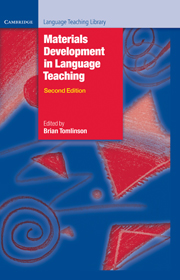Book contents
- Frontmatter
- Contents
- Preface
- Glossary of basic terms for materials development in language teaching
- Acknowledgements
- 1 Introduction: principles and procedures of materials development
- Part A Data collection and materials development
- 2 Using corpora in the language classroom
- 3 Concordances in the classroom without a computer: assembling and exploiting concordances of common words
- 4 Telling tails: grammar, the spoken language and materials development
- Comments on Part A
- Part B The process of materials writing
- 5 A framework for materials writing
- 6 Writing course materials for the world: a great compromise
- 7 How writers write: testimony from authors
- Comments on Part B
- Part C The process of materials evaluation
- 8 The analysis of language teaching materials: inside the Trojan Horse
- 9 Macro- and micro-evaluations of task-based teaching
- 10 What do teachers really want from coursebooks?
- 11 The process of evaluation: a publisher’s view
- Comments on Part C
- Part D The electronic delivery of materials
- 12 Developing language-learning materials with technology
- 13 New technologies to support language learning
- Comments on Part D
- Part E Ideas for materials development
- 14 Seeing what they mean: helping L2 readers to visualise
- 15 Squaring the circle – reconciling materials as constraint with materials as empowerment
- 16 Lozanov and the teaching text
- 17 Access-self materials
- Comments on Part E
- Conclusions
- Recommended reading
- Index
Comments on Part E
Published online by Cambridge University Press: 09 February 2023
- Frontmatter
- Contents
- Preface
- Glossary of basic terms for materials development in language teaching
- Acknowledgements
- 1 Introduction: principles and procedures of materials development
- Part A Data collection and materials development
- 2 Using corpora in the language classroom
- 3 Concordances in the classroom without a computer: assembling and exploiting concordances of common words
- 4 Telling tails: grammar, the spoken language and materials development
- Comments on Part A
- Part B The process of materials writing
- 5 A framework for materials writing
- 6 Writing course materials for the world: a great compromise
- 7 How writers write: testimony from authors
- Comments on Part B
- Part C The process of materials evaluation
- 8 The analysis of language teaching materials: inside the Trojan Horse
- 9 Macro- and micro-evaluations of task-based teaching
- 10 What do teachers really want from coursebooks?
- 11 The process of evaluation: a publisher’s view
- Comments on Part C
- Part D The electronic delivery of materials
- 12 Developing language-learning materials with technology
- 13 New technologies to support language learning
- Comments on Part D
- Part E Ideas for materials development
- 14 Seeing what they mean: helping L2 readers to visualise
- 15 Squaring the circle – reconciling materials as constraint with materials as empowerment
- 16 Lozanov and the teaching text
- 17 Access-self materials
- Comments on Part E
- Conclusions
- Recommended reading
- Index
Summary
The chapters in this section offer very different views on materials development but have many things in common. One thing in particular that they have in common is their concern that different types of learners and different preferred styles of learning should be catered for in language-learning materials. An analysis of any current global coursebook will reveal that it favours the analytic learner rather than the experiential learner (Masuhara et al . 2008 ; Tomlinson et al . 2001 ), that it caters for the visual learner more than it does for the auditory learner and that hardly any provision is made for the tactile or kinaesthetic learner. Yet it seems that more learners are experiential than analytic and that the preferred mode for most learners is the kinaesthetic (Oxford and Anderson 1995 ). It is not difficult to work out why coursebook materials typically favour the analytic learner. The school cultures which the teachers, learners, publishers and textbook writers come from encourage and reward those who are primarily analytic. The learners who succeed in these cultures are those who can focus on discrete chunks of information, who can analyse and categorise, who can memorise and retrieve consciously, who are systematic and sequential in the ways that they learn. Most teachers, writers and publishers have been successful in such cultures; most learners expect to learn languages in the same analytical ways that they have been made to learn other subjects at school; and most parents and administrators want languages to be learned in an analytic way which rewards effort and application and teaches the values of order and conformity. And it does not help when language acquisition researchers categorise the good language learner as someone who uses the appropriate learning strategies effectively, who monitors themselves and others, who pays attention to form and to meaning, who practises the language and who is aware of the learning process (Ellis 1994 : 546–50). In other words, the good language learner is someone who is flexible but who learns the language primarily by focusing attention on aspects of it. And, of course, such a learner is identified as a good learner by teachers who are following a primarily analytic course and is rewarded by language examinations which feature tasks which are primarily analytic too.
- Type
- Chapter
- Information
- Materials Development in Language Teaching , pp. 433 - 436Publisher: Cambridge University PressPrint publication year: 2011

